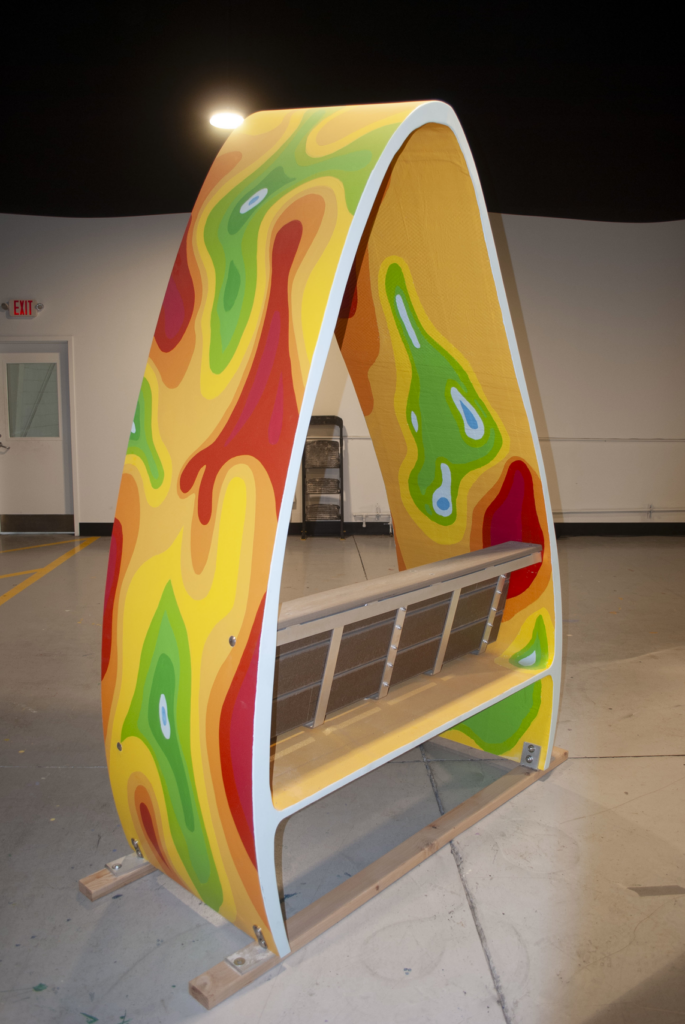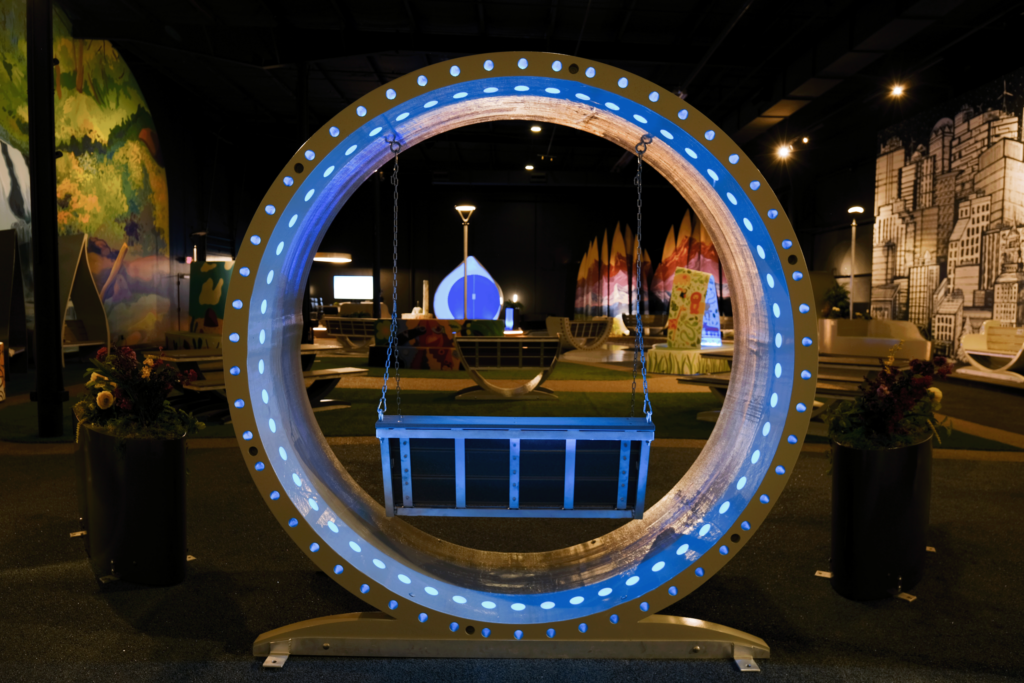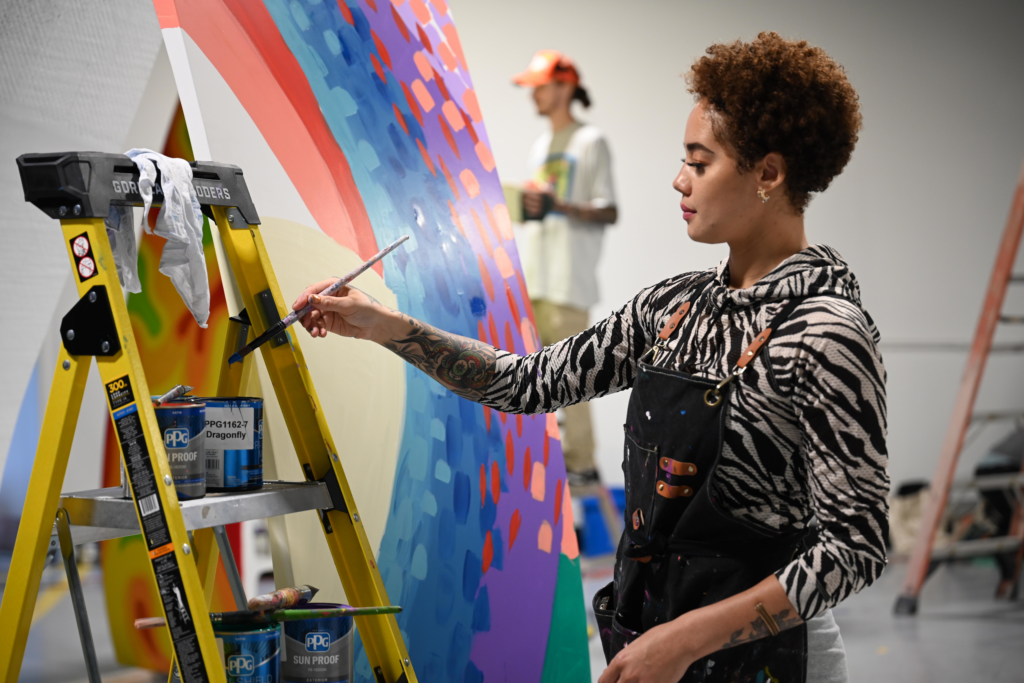When turbine blades reach the end of their life, an Ohio company turns them into functional public art.
The apparent misspelling of the Cleveland-area company Canvus — which recycles retired wind turbines into decorated outdoor furniture appearing in public places around Northeast Ohio and beyond — is no mistake. It’s an intentional play on the word “canvas,” because the green-focused company sees its mission as something that benefits all of “us” by keeping large items out of landfills and instead using them to beautify the outdoors with benches, tables, and planters.
“Our furniture is built to be out in communities, and painted by artists, and purchased and donated to communities,” said Brian Donahue, managing partner of Canvus. “It speaks to the fact that it’s a canvas for all of us. … That’s why we use ‘us.’”
The roughly fifty pieces of functional public art that have appeared in greater Cleveland, Donahue said, are “not a product you’re going to see in someone’s backyard.” Turbine blades, he said, are highly durable.
“Your typical park bench or picnic table in the park lasts five to seven years. These will last another twenty-five to thirty years.”
Based in Rocky River, Ohio, Donahue’s company is repurposing items many of us don’t think of as landfill materials, namely fiberglass wind turbine blades that are roughly 150 feet long and weigh between 20,000 and 30,000 pounds. With proper maintenance, these blades run well for twenty-five to thirty years. In any given year in the U.S., Donahue said, between 3,000 and 8,000 blades come down from their towers and are replaced with higher-efficiency ones. An older blade might produce one megawatt, Donohue explained, while a new one creates four.
Typically, these older blades end up in landfills. Made of fiberglass, the blades are not going to biodegrade. In Donohue’s view, “They don’t belong there, and they shouldn’t be there.” But until Canvus, there were few solutions for disposing of the blades. In a way, he said, installing new, more efficient blades swapped one environmental problem for another. “You have this green energy movement, and you have renewable energy, and all of a sudden, the story is written: Well, they’re not that green,” Donahue said. “Look at these piles of blades buried in these landfills!”
One alternative to burying the blades is to grind them up into additives for asphalt and concrete. This might be better than putting them into a landfill, but it’s energy-intensive. Canvas grew out of Donohue’s desire to seek an alternative that didn’t use as much energy.
Canvus collects retired blades donated primarily from wind farms in Iowa, Texas, and North Dakota. Workers cut the blades at the wind farms into “fillets” about forty to fifty feet long. At the Ohio plant, workers further cut and mold the blade fiberglass and add other materials, such as rubber from tires, ground-up shoes, and composite lumber. Artists are then invited (or apply) to paint the various creations.
Many Canvus benches, tables and planters — which come in a variety of styles — are in greater Cleveland. Two teardrop-shaped Willow benches, for example, decorate the entrance to the city’s Great Lakes Science Center. But Canvus is also drawing customers from around the country, shipping items to California and Texas. Frequently, city parks and recreation departments purchase Canvus items; even the San Francisco 49ers now have a Canvus bench.
Donahue — who doesn’t know of any other company doing exactly what his does — expects to recycle anywhere from 15,000 to 30,000 tons of fiberglass blades each year, turning them into furniture. Donohue sees his business as doing more than simply recycling materials. He’s helping create functional public art, and “it’s really a nice relationship,” he said. “Communities are very supportive of art, but you can’t really interact with a mural. [With] ours, you can sit on it and have a cup of coffee and talk to your friend in the park.”
He adds that “artists always have a hard time getting their work recognized. Canvas is providing artists a way to give back that will make “a real lasting impression.”






